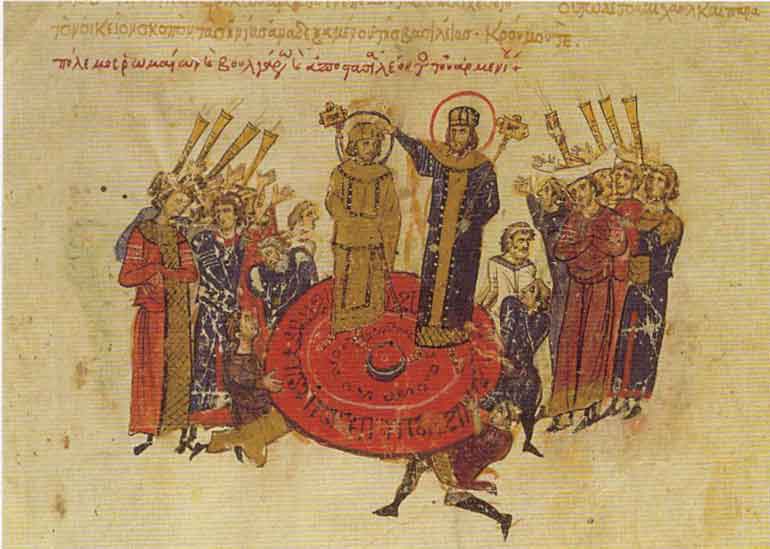.

A coin of Byzantine Emperor Michael I (811-813AD) AE follis struck at Syracuse, Sicily depicting Michael crowned, wearing a chlamys and holding a globus cruciger. inscription:MIXA
Michael I Rangabe (Greek: Μιχαήλ Α΄ Ραγγαβέ, Mikhaēl I Rangabe), (died January 11, 844) was Byzantine emperor (811 - 813).
Michael was the son of the patrician Theophylaktos Rangabe, the admiral of the Aegean fleet. He married Prokopia, the daughter of the future Emperor Nikephoros I, received the high court dignity of kouropalatēs after his father-in-law's accession in 802.
Michael survived Nikephoros' disastrous campaign against Krum of Bulgaria, and was considered a more appropriate candidate for the throne than his severely injured brother-in-law Staurakios. When Michael's wife Prokopia failed to persuade her brother to name Michael as his successor, Michael's supporters forced Staurakios to abdicate in his favor on October 2, 811.
Michael I attempted to carry out a policy of reconciliation, abandoning the exacting taxation instituted by Nikephoros I. While reducing imperial income, Michael generously distributed money to the army, the bureaucracy, and the Church. Elected with the support of the Orthodox party in the Church, Michael diligently persecuted the iconoclasts and forced the Patriarch Nikephoros to back down in his dispute with Theodore of Stoudios, the influential abbot of the monastery of Stoudios. Michael's piety won him a very positive estimation in the work of the chronicler Theophanes the Confessor.

Michael I proclaims Leo V the Armenian as so-emperor in 813.
Illuminated manuscript of John Scylitzes.
In 812 Michael I reopened negotiations with the Franks, and recognized Charlemagne as "basileus (emperor) of the Franks", in exchange for the return of Venice and Istria to the Byzantine Empire. However, under the influence of Theodore, Michael rejected the peace terms offered by Krum and provoked the capture of Mesembria (Nesebar) by the Bulgarians. After an initial success in spring 813, Michael's army prepared for a major engagement at Versinikia near Adrianople in June. The Byzantine army was turned to flight and the emperor's position was seriously weakened. With conspiracy in the air, Michael preempted events by abdicating in favor of the general Leo the Armenian and becoming a monk (under the name Athanasios). His sons were castrated and relegated into monasteries, one of them, Niketas (renamed Ignatios), eventually becoming Patriarch of Constantinople. Michael died peacefully in January 844.
Family
By his wife Prokopia, Michael I had at least five children:
- Theophylaktos, co-emperor from 812 to 814.
- Staurakios
- Niketas, later Patriarch Ignatios of Constantinople.
- Georgo
- Theophano
Sources
- The Oxford Dictionary of Byzantium, Oxford University Press, 1991.
- Gibbon, Edward. The History of the Decline and Fall of The Roman Empire Vol 4, 2005
- This article incorporates text from the Encyclopædia Britannica Eleventh Edition, a publication now in the public domain.
Preceded by: Staurakios
Byzantine Emperor
Succeeded by: Leo V
| Ancient Greece
Science, Technology , Medicine , Warfare, , Biographies , Life , Cities/Places/Maps , Arts , Literature , Philosophy ,Olympics, Mythology , History , Images Medieval Greece / Byzantine Empire Science, Technology, Arts, , Warfare , Literature, Biographies, Icons, History Modern Greece Cities, Islands, Regions, Fauna/Flora ,Biographies , History , Warfare, Science/Technology, Literature, Music , Arts , Film/Actors , Sport , Fashion --- |
Retrieved from "http://en.wikipedia.org"
All text is available under the terms of the GNU Free Documentation License

